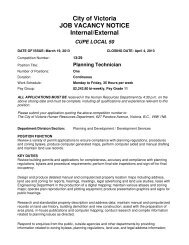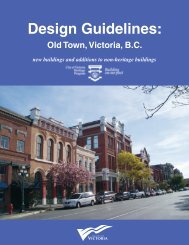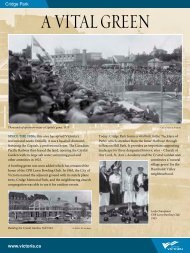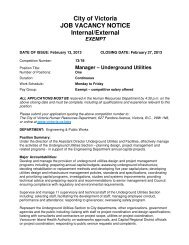Roundhouse Design Guidelines - Victoria
Roundhouse Design Guidelines - Victoria
Roundhouse Design Guidelines - Victoria
You also want an ePaper? Increase the reach of your titles
YUMPU automatically turns print PDFs into web optimized ePapers that Google loves.
APPENDIX A.2<br />
SUSTAINABLE DEVELOPMENT BEST PRACTICES REFERENCE<br />
Sustainable development requires the balancing of environmental, social<br />
and economic considerations. In addition to the sustainable features of<br />
<strong>Roundhouse</strong> inherent in its program of mixed-use development, heritage<br />
rehabilitation, historic building reuse, environmental remediation and brownfield<br />
redevelopment, <strong>Roundhouse</strong> intends to follow best practices with respect to<br />
sustainable development and green building strategies.<br />
Accordingly, it is intended that all new buildings at <strong>Roundhouse</strong> be designed<br />
to meet green building design standards as set by LEED or similar standards.<br />
Building and landscape design should be consistent with Smart Growth<br />
principles and demonstrate a commitment towards environmental performance<br />
and stewardship. Specific design elements that make a positive contribution to<br />
the overall sustainability of the neighbourhood are required.<br />
The following topics are presented for information and reference purposes<br />
only and are not subject to review at the Development Permit stage.<br />
1.1 Environmental Sustainability<br />
Current best practices in the proposed building’s environmental and energy<br />
performance may included, but are not limited to the following:<br />
1.1. 1 Sustainable Building Techniques<br />
Sustainable building techniques, including higher levels of building insulation,<br />
water use efficiency, locally manufactured products and materials, recycled and<br />
“healthy” materials and finishes.<br />
a) Foundation, Structural Frame, and Building Envelope:<br />
• Build rain and groundwater dispersion elements into the foundation to<br />
prevent unwanted moisture.<br />
• Use concrete with a fly ash content of approximately 25%. Concrete with<br />
fly ash content is stronger, more durable, easier to work with, requires less<br />
water, and is a more cost-effective option.<br />
• Use high recycled-content steel framing, where applicable.<br />
• Specify recycled aggregate for fill, back fill, and other uses.<br />
• Increase thermal mass to reduce heating and cooling energy use and<br />
moderate indoor temperature.<br />
b) Insulation:<br />
• Install Recycled-Content Insulation: most building insulation contains<br />
some recycled content. Using products with high post-consumer recycled<br />
content reduces reliance on raw materials and reduces landfill deposits.<br />
R O U N D H O U S E D E S I G N G U I D E L I N E S J u l y 2 0 0 8 49




![Victoria-Changsha Friendship City Signing Ceremony [PDF - 143 KB]](https://img.yumpu.com/50875401/1/190x245/victoria-changsha-friendship-city-signing-ceremony-pdf-143-kb.jpg?quality=85)
![Victoria's Paralympic Torch Relay and Celebration Plans [PDF - 64 KB]](https://img.yumpu.com/49727313/1/190x245/victorias-paralympic-torch-relay-and-celebration-plans-pdf-64-kb.jpg?quality=85)

![Cecelia Ravine Park Management Plan [PDF - 1.4 MB] - Victoria](https://img.yumpu.com/46438167/1/190x245/cecelia-ravine-park-management-plan-pdf-14-mb-victoria.jpg?quality=85)

![View the House Names (Alphabetical List) [PDF - 64 KB] - Victoria](https://img.yumpu.com/46379892/1/190x245/view-the-house-names-alphabetical-list-pdf-64-kb-victoria.jpg?quality=85)


![View the list of Private Records (By Number) [PDF - 295 KB] - Victoria](https://img.yumpu.com/42964883/1/190x245/view-the-list-of-private-records-by-number-pdf-295-kb-victoria.jpg?quality=85)




![General Maps (By Subject) [PDF - 40 KB] - Victoria](https://img.yumpu.com/35594040/1/190x245/general-maps-by-subject-pdf-40-kb-victoria.jpg?quality=85)